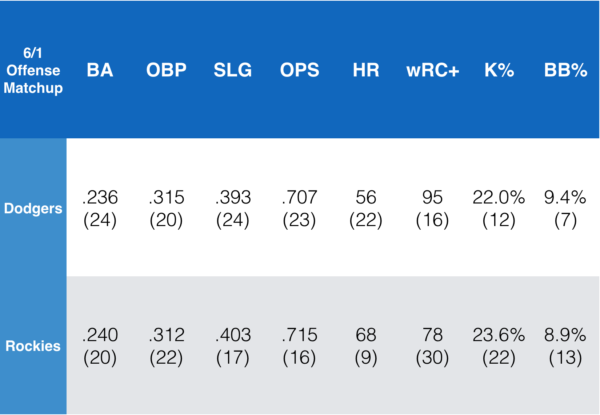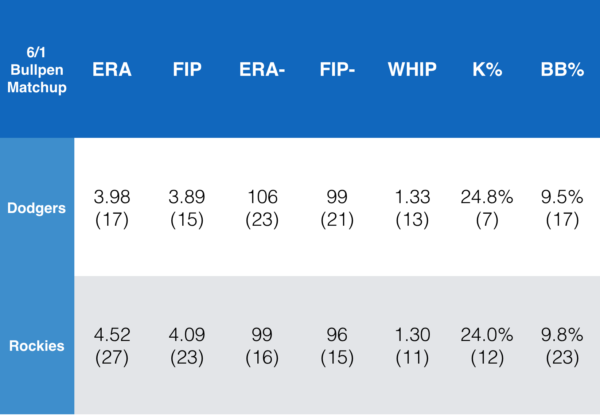
Today the Dodgers are in Denver to begin a big weekend series with the Rockies, who have fallen upward into first place due to the precipitous decline of the Diamondbacks. The Dodgers start play four games behind Colorado, with a chance to add or lose significant ground while playing in the stadium which has seemed to haunt them most. Seeing Matt Kemp play in the outfield will certainly bring back terrible memories for both him and Dodger fans. Given the amount of names already on the Dodgers’ disabled list, they can ill-afford additional players falling victim to the curse of Coors Field.

The Dodgers will be facing lefty Tyler Anderson to begin the series. Anderson has had a rough start to the year, posting ERAs and FIPs near 5 in his first 55 innings this season. Anderson is missing fewer bats this year and has already surrendered 10 home runs. His arsenal mainly features fastballs, with a low-90s fourseam used about 40% of the time, a high-80s cutter used about 20% of the time, and a low-90s sinker used about 10% of the time. He fills in the rest with changeups and an occasional curve.

Anderson is not necessarily a formidable opponent, but Dave Roberts has elected to sit the slumping Cody Bellinger regardless. Speaking of Bellinger, Dustin wrote a piece about him for True Blue LA earlier today. Dustin argues that Bellinger should stay at first base full-time, which is not necessarily something that I agree with, but it’s interesting food for thought. At any rate, I would not be upset to see him avoid the cavernous (and carnivorous?) outfield in Denver this weekend.
|
Dodgers
|
Rockies
|
|||
|---|---|---|---|---|
|
5:35 p.m.
|
Denver, CO.
|
|||
|
SS
|
Taylor |
2B
|
LeMahieu | |
|
3B
|
Turner |
CF
|
Blackmon | |
|
LF
|
Kemp |
3B
|
Arenado | |
|
CF
|
Hernández |
RF
|
González | |
|
1B
|
Muncy |
SS
|
Story | |
|
2B
|
Forsythe |
LF
|
Parra | |
|
C
|
Barnes | 1B | Desmond | |
|
RF
|
Puig |
C
|
Ianetta | |
|
P
|
Alexander (L)
|
P
|
Anderson (L)
|
Tonight’s game will likely mark Dennis Santana‘s big league debut. However, instead of starting the starting pitcher they just called up, the Dodgers are electing to go with Scott Alexander to begin the game. This could be interpreted in two ways: as buy-in to the Rays’ recent “opener” strategy, or treating today as a standard “bullpen game.” Both are bad ideas.
First, if this is a traditional “bullpen game,” with Santana only going a few innings, that seems like a bad use of resources. The Dodgers are opening a series in Denver, where the bullpen will likely be needed a lot due to the general environment. Alex Wood‘s status tomorrow seems uncertain (today’s rotation vacancy was caused in part by the need to push Wood back a day due to muscular cramps) and Denver is difficult on pitchers. The bullpen is also only a few days removed from needing to pitch 7-1/3 innings due to Maeda’s departure. The Dodgers recalled Brock Stewart before today’s game to replace Clayton Kershaw, who has been moved to the disabled list due to his back issue, so at least they’ll have an extra arm to work with. However, asking for extra length from the bullpen today doesn’t make a lot of sense in the context of the rest of this series.
The other interpretation of this game is as an implementation of the Rays’ “opener” strategy, in which a match-up reliever is inserted into the game at the start, then the traditional “starter” fills in the innings later on. Beyond the “opener” appearing to be a way to reduce salaries in arbitration, there are other issues with the specific implementation the Dodgers have selected.
First, while Scott Alexander is left-handed, his splits are not very big. Over the course of his career, he has allowed a .298 wOBA to left-handed batters and a .304 wOBA to right-handed batters. If you think about the way Alexander pitches, it makes sense. He throws a sinker the vast majority of time, pitching to contact. Platoon splits generally come from four-seamers, curves, and sliders. Alexander doesn’t throw many of those. Also, the Rockies have countered the attempt to matching up splits by reinstating the right-handed DJ LeMahieu from the disabled list and hitting him lead-off. Charlie Blackmon, a lefty, is batting second, and Nolan Arenado (right-handed) is batting third.
The “opener” strategy also risks putting more undue pressure on the bullpen. If Alexander can’t make it through the first inning (and the evidence that he has been “fixed” is limited to eight innings), the Dodgers probably cannot just insert Santana in to make his debut in a non-clean inning scenario. In that case, they’ll need to use two high-leverage relievers before the starter/long-man even enters the game.
The counter that the “opener” will pitch just as long in relief as he would in a start is not necessarily true in the National League, either. Consider how often starting pitchers are pulled due to the arrival of their spot in the batting order in the fifth or sixth inning. That batting order spot will arrive at the same time in the game, barring a double-switch (which is less likely with a four man bench). If that batting spot is in a high-leverage situation, Santana will likely be pulled regardless of how many innings he has pitched. That lengthens the bullpen load. Over the long-term, if the long reliever is left in the game as long as a starter would be, pitchers will hit more. That’s a negative in the margins, countering whatever positive this strategy would bring in those same margins.
This, of course, all ignores the effect of altering Santana’s routine. The Dodgers know Santana and I do not, so they better know how this will effect him. However, if the benefits of an “opener” are marginal (Santana facing Blackmon and maybe Carlos Gonzalez one fewer time given the same outing length) and the downsides are present, why bother? Any gains are at least significantly offset by the losses in the margins. Hopefully this does not become a routine for the Dodgers, because it seems like it’s just being clever for the sake of being clever, rather than adding any significant strategic gain.
 Dodgers Digest Los Angeles Dodgers Baseball Blog
Dodgers Digest Los Angeles Dodgers Baseball Blog